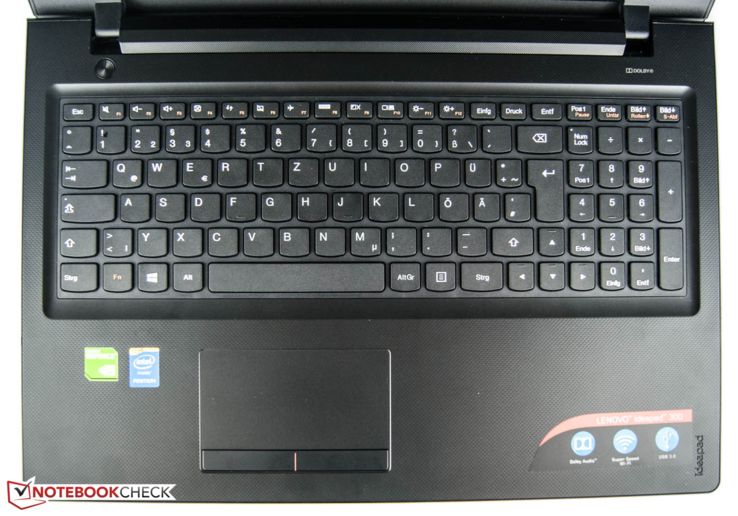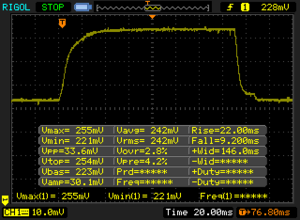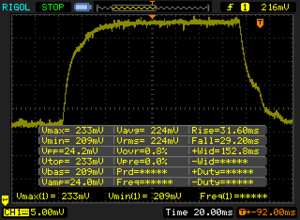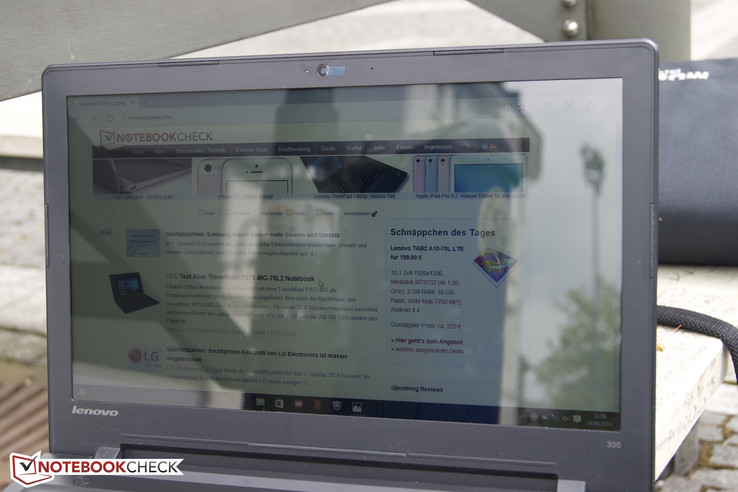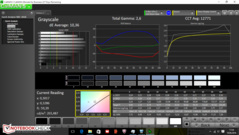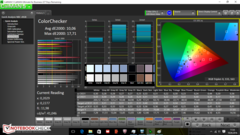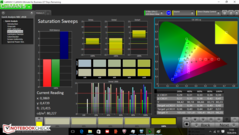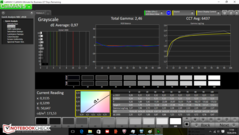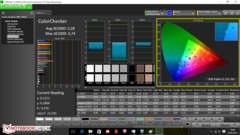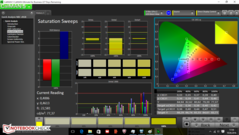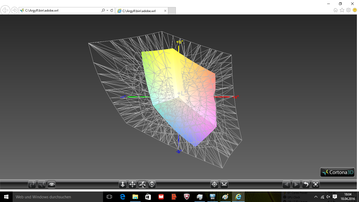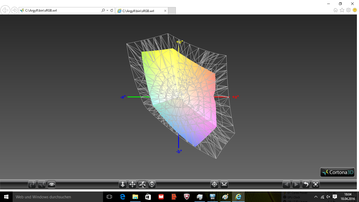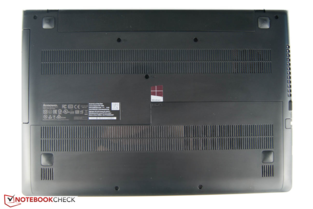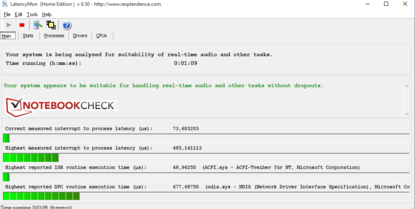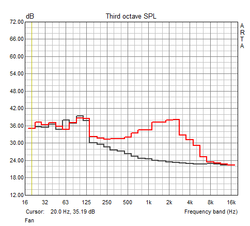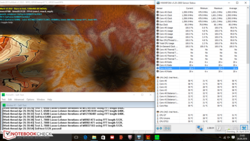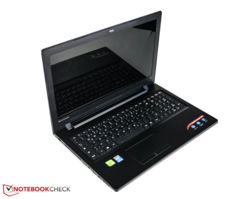Lenovo IdeaPad 300-15IBR Notebook Review

For the original German review, see here.
The new 300-series Ideapad from Lenovo is designed to handle the various daily tasks users might encounter. The dedicated GPU should also allow some headroom for multimedia applications. Lenovo decided on a rather unusual combination of a low-end 1.6 GHz Intel Pentium CPU with a Nvidia GeForce 920M GPU. The notebooks has 4 GB of RAM on board and comes with a 1 TB HDD. At the time of writing, the price is 450 Euro (~$500). For just 50 Euro (~$) more, users could opt for a HP notebook (series 250-G4), which comes equipped with a more powerful Intel Core i5-5200U and double the RAM. The GPU is a dedicated AMD Radeon R5 M330. The Asus F555LJ - which now costs about the same as the review notebook - also makes for an interesting comparison. The F555LJ comes with 8 GB of RAM and an Intel Core i3-5010U processor.
Case & Connectivity
The chassis of the Ideapad 300 is typical for Lenovo notebooks. The design is simple and the matte black plastic elements offer enough grip to hold the notebook securely. Closer examination reveals many sharp corners end edges. Some of the gaps between the materials are not even and the maintenance hatch on the bottom isn't quite flush with the rest of the unit. Another negative aspect: the back of the display lid flexes easily when pressure is applied.
As we mentioned earlier, the notebook comes with a maintenance cover. The cover, which is attached with two screws, allows access to the HDD, the wireless module, the RAM slot (1/1 slot occupied), and the CMOS battery. The battery is also removable, but requires tools as well. The 15.6-inch notebook is 23.4 mm thick and weighs 2.3 kg, so it is pretty easy to transport.
The port selection is typical for this type of notebook. Quite disappointing is the fact that only one of the USB ports supports USB 3.0. The ports are located towards the front on both sides, which makes accessing them quite easy, although plugged-in cables could potentially get in the way. The SD card reader is sufficiently fast. With our reference SD card Toshiba Exceria Pro SDXC 64 GB UHS-II, we registered 61.4 MB/s when transferring 5 MB JPEG files. The tool AS SSD posted even higher read and write rates of 76.77 MB/s and 73.65 MB/s, respectively.
Input Devices
Lenovo also uses the same keyboard design in other notebooks. Key travel is short and soft, which makes typing the response feel a little spongy. 10-finger touch typists might also need some time to get used to the feedback. Plus points are the adequate size of the keys and the dedicated number pad. The entire keyboard flexes too much while typing. Business users are better off with an external keyboard.
The touchpad underneath the keyboard is large enough at 10 x 5.3 cm and inputs are translated accurately save for the corners. Multitouch gestures are recognized most of the time, but more expensive notebooks feel more intuitive and natural than the review candidate. The two physical mouse buttons under the touchpad produce a muffled sound at the outer edges but a rather obtrusive, higher-frequency clicking-sound towards the middle.
Display
The Ideapad 300 is equipped with a glossy TN panel from LG. The display with a resolution of 1366 x 768 pixels doesn't get very bright: we measured an average of only 192 cd/m². The competitors are not much better, however. Lenovo doesn't offer a different display type at this time. We also couldn't find our review notebook on Lenovo's website, although it's available from several online shops.
| |||||||||||||||||||||||||
Brightness Distribution: 81 %
Center on Battery: 205 cd/m²
Contrast: 703:1 (Black: 0.29 cd/m²)
ΔE Color 10.06 | 0.5-29.43 Ø5
ΔE Greyscale 10.36 | 0.57-98 Ø5.3
55.97% sRGB (Argyll 1.6.3 3D)
35.51% AdobeRGB 1998 (Argyll 1.6.3 3D)
38.34% AdobeRGB 1998 (Argyll 2.2.0 3D)
55.8% sRGB (Argyll 2.2.0 3D)
37.1% Display P3 (Argyll 2.2.0 3D)
Gamma: 2.6
| Lenovo IdeaPad 300-15IBR GeForce 920M, N3700, Seagate Momentus SpinPoint M8 ST1000LM024 HN-M101MBB | HP 250 G4 T6P08ES Radeon R5 M330, 5200U, HGST Travelstar 5K1000 HTS541010A9E680 | Lenovo G51-35 80M8002HGE Radeon R5 (Beema/Carrizo-L), A8-7410, WDC Scorpio Blue WD10JPCX-24UE4T0 | Asus F555LJ-XX110H GeForce 920M, 5010U, Hitachi Travelstar Z5K500 HTS545050A7E680 | |
|---|---|---|---|---|
| Display | 18% | 1% | 19% | |
| Display P3 Coverage | 37.1 | 43.63 18% | 37.59 1% | 44.34 20% |
| sRGB Coverage | 55.8 | 65.1 17% | 56.3 1% | 66.1 18% |
| AdobeRGB 1998 Coverage | 38.34 | 45.1 18% | 38.85 1% | 45.95 20% |
| Response Times | 27% | 23% | ||
| Response Time Grey 50% / Grey 80% * | 60.8 ? | 42 ? 31% | 43.6 ? 28% | |
| Response Time Black / White * | 31.2 ? | 24 ? 23% | 25.6 ? 18% | |
| PWM Frequency | 806 ? | 200 ? | ||
| Screen | -4% | 2% | 18% | |
| Brightness middle | 204 | 220 8% | 206 1% | 245 20% |
| Brightness | 192 | 203 6% | 195 2% | 236 23% |
| Brightness Distribution | 81 | 83 2% | 88 9% | 86 6% |
| Black Level * | 0.29 | 0.49 -69% | 0.35 -21% | 0.31 -7% |
| Contrast | 703 | 449 -36% | 589 -16% | 790 12% |
| Colorchecker dE 2000 * | 10.06 | 8.95 11% | 8.96 11% | 6.6 34% |
| Colorchecker dE 2000 max. * | 17.71 | 15.89 10% | 14.26 19% | |
| Greyscale dE 2000 * | 10.36 | 10.59 -2% | 9.27 11% | 6.96 33% |
| Gamma | 2.6 85% | 2.51 88% | 2.38 92% | 2.35 94% |
| CCT | 12771 51% | 12049 54% | 11213 58% | 8450 77% |
| Color Space (Percent of AdobeRGB 1998) | 35.51 | 41 15% | 35.89 1% | 43 21% |
| Color Space (Percent of sRGB) | 55.97 | 65 16% | 56.26 1% | 66 18% |
| Total Average (Program / Settings) | 14% /
5% | 9% /
4% | 19% /
18% |
* ... smaller is better
Display Response Times
| ↔ Response Time Black to White | ||
|---|---|---|
| 31.2 ms ... rise ↗ and fall ↘ combined | ↗ 22 ms rise | |
| ↘ 9.2 ms fall | ||
| The screen shows slow response rates in our tests and will be unsatisfactory for gamers. In comparison, all tested devices range from 0.1 (minimum) to 240 (maximum) ms. » 82 % of all devices are better. This means that the measured response time is worse than the average of all tested devices (21.5 ms). | ||
| ↔ Response Time 50% Grey to 80% Grey | ||
| 60.8 ms ... rise ↗ and fall ↘ combined | ↗ 31.6 ms rise | |
| ↘ 29.2 ms fall | ||
| The screen shows slow response rates in our tests and will be unsatisfactory for gamers. In comparison, all tested devices range from 0.2 (minimum) to 636 (maximum) ms. » 96 % of all devices are better. This means that the measured response time is worse than the average of all tested devices (33.7 ms). | ||
Screen Flickering / PWM (Pulse-Width Modulation)
| Screen flickering / PWM not detected | ||
In comparison: 53 % of all tested devices do not use PWM to dim the display. If PWM was detected, an average of 17900 (minimum: 5 - maximum: 3846000) Hz was measured. | ||
Color and grayscale deviations are usually pretty high for TN panels. The measured DeltaE deviations are around 10 and the panel exhibits a distinctly bluish hue. Calibration fortunately takes care of it. Of course this type of notebook is not intended for professional use anyway.
Users who'd like to venture outside a lot face two drawbacks, as the display is not only quite dim, but also plagued by reflections. Working is only possible in the shade and darker environments.
Performance
Our version of the IdeaPad 300 is equipped with a very low-end processor and a dedicated Nvida GPU, which should offer sufficient performance for multimedia applications and older games. The RAM (4 GB in our case) only operates in single-channel mode. Expansion is only possible if the 4 GB module is removed and replaced with a larger one, since Lenovo only integrated one slot. The review notebook has very basic hardware designed to tackle web browsing and similar. tasks. The dedicated GPU has some headroom as far as multimedia applications are concerned.
Processor
The Intel Pentium N3700 has four cores and is clocked at 1.6 GHz. The Braswell-generation CPU is also quite frugal with a TDP of only 6 watts. The Turbo Boost can overclock the CPU to a maximum of 2400 MHz. The N3700 scored 132 points in the Cinebench R15 benchmark test, so the performance is exactly as expected. The competitors with more powerful processors score much higher: the HP 250 G4, for example, manged an impressive 257 points.
Even though the performance is far from stellar in the first place, using the notebook away from outlets curtails the performance further. A check with the Cinebench R15 benchmark showed a 24 % point reduction when we operated the notebook on its battery.
System Performance
Because of the low-end CPU and slow conventional hard drive, the 15.6-inch notebook unfortunately feels far from speedy. Running several programs in parallel also caused visible stutters. The PCMark 8 Home test confirmed our subjective impression with a score of only 1740 points. Competing notebooks with more RAM and faster CPU generally score about 3000 points.
| PCMark 8 - Home Score Accelerated v2 | |
| HP 250 G4 T6P08ES | |
| Asus F555LJ-XX110H | |
| Lenovo IdeaPad 300-15IBR | |
| PCMark 7 - Score | |
| HP 250 G4 T6P08ES | |
| Asus F555LJ-XX110H | |
| Lenovo IdeaPad 300-15IBR | |
| PCMark 7 Score | 1806 points | |
| PCMark 8 Home Score Accelerated v2 | 1740 points | |
Help | ||
Storage Devices
A 1 TB conventional Seagate HDD handles the data storage. The platter-based drive rotates at 5400 RPM and delivers sequential read and write rates of 99.69 and 96.43 MB/s, respectively. Thanks to the maintenance cover, swapping out the hard drive is easily accomplished.
| Lenovo IdeaPad 300-15IBR GeForce 920M, N3700, Seagate Momentus SpinPoint M8 ST1000LM024 HN-M101MBB | Asus F555LJ-XX110H GeForce 920M, 5010U, Hitachi Travelstar Z5K500 HTS545050A7E680 | HP 250 G4 T6P08ES Radeon R5 M330, 5200U, HGST Travelstar 5K1000 HTS541010A9E680 | |
|---|---|---|---|
| CrystalDiskMark 3.0 | 1% | 30% | |
| Read Seq | 99.7 | 99.5 0% | 101 1% |
| Write Seq | 96.4 | 98.2 2% | 99.6 3% |
| Read 4k | 0.368 | 0.349 -5% | 0.522 42% |
| Write 4k | 0.737 | 0.775 5% | 1.29 75% |
GPU Performance
One distinctive feature of the notebook is the GPU. Instead of relying on the processor-integrated GPU, Lenvo makes use of a dedicated graphics card as well. Our review notebook comes equipped with an Nvidia GeForce 920M. This low-end GPU comes with 2 GB of RAM, runs at a base frequency of 954 MHz and can handle most graphics-related tasks. Most current games pose a problem though and only a few of them are playable at the lowest settings. With a 3DMark 11 score of 1573 points, the notebooks slightly trails the Asus F555LJ with the same GPU. The more powerful HP 250 G4 with its AMD Radeon M330 leads the pack with 1927 points. Overall, the review notebook scores about 10 % less than expected. The rather basic CPU is likely the culprit.
Just like the CPU performance, the GPU performance drops unfortunately when the notebook is running on battery. We observed a decline of about 7 %.
| 3DMark 11 Performance | 1573 points | |
Help | ||
Gaming Performance
Should gaming be on the agenda, we advise sticking with older games. BioShock Infinite, to give one example, runs at 28.5 fps at medium settings.
| BioShock Infinite | |
| 1280x720 Very Low Preset | |
| MSI CX61 2QC 2970M MS-16GD | |
| Asus F555LJ-XX110H | |
| Toshiba Satellite C55-C-1NE | |
| HP 250 G4 T6P08ES | |
| Lenovo IdeaPad 300-15IBR | |
| 1366x768 Medium Preset | |
| Asus P2520LJ-DF0014G | |
| MSI CX61 2QC 2970M MS-16GD | |
| Toshiba Satellite C55-C-1NE | |
| Asus F555LJ-XX110H | |
| Lenovo IdeaPad 300-15IBR | |
| HP 250 G4 T6P08ES | |
| low | med. | high | ultra | |
| BioShock Infinite (2013) | 40.9 | 28.53 | 24.8 |
Emissions & Energy
Noise Level
The Lenovo Ideapad is pretty quiet overall, but remains audible most of the time. Especially with the performance profile activated, the fan noise is always present, although - at a maximum of 37.6 dB(A) - the system never gets as loud as the HP 250 G4 (45.2 dB(A)) or the Asus F555LJ (41.8 dB(A)). Unfortunately, the fan noise occurs in the upper frequency range and is therefore a little more obtrusive than we like.
Noise Level
| Idle |
| 30.4 / 30.4 / 34.3 dB(A) |
| HDD |
| 30.5 dB(A) |
| Load |
| 36.2 / 37.6 dB(A) |
 | ||
30 dB silent 40 dB(A) audible 50 dB(A) loud |
||
min: | ||
Temperature
Temperatures are well-controlled both at idle and under load. We measured a maximum of 36 °C at the top and the bottom. The competitors fall within the same range. The power adapter does get quite hot though at up to 51.4 °C, so covering it up with a blanket would be a bad idea.
Last, we also take a look at the internal temps and subject the notebook to our stress test for at least one hour. The processor was able to maintain the base frequency of 1.6 GHz for the duration and the core temperatures never exceeded 60 °C. A quick check after the stress test showed identical performance compared to right after a cold start according to the 3DMark 11 benchmark test.
(+) The maximum temperature on the upper side is 36.7 °C / 98 F, compared to the average of 36.9 °C / 98 F, ranging from 21.1 to 71 °C for the class Multimedia.
(+) The bottom heats up to a maximum of 36.6 °C / 98 F, compared to the average of 39.1 °C / 102 F
(+) In idle usage, the average temperature for the upper side is 26.6 °C / 80 F, compared to the device average of 31.2 °C / 88 F.
(+) The palmrests and touchpad are reaching skin temperature as a maximum (32.1 °C / 89.8 F) and are therefore not hot.
(-) The average temperature of the palmrest area of similar devices was 28.8 °C / 83.8 F (-3.3 °C / -6 F).
Speakers
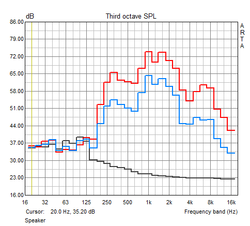
The speakers are decent enough even for extended YouTube sessions and watching a TV series. The maximum volume level is adequate and voices are easy to understand. Of course, this is a run-of-the-mill speaker system and as such, it can't deliver quite the range and depth one would hope for.
Power Consumption
The Lenovo Ideapad 300 requires between 5.4 and 9.4 watts during idle. The more powerful competitors actually require less: the Asus F555LJ draws between 3.5–5.7 watts. Even under load the review notebook is far less frugal and requires 5 watts more (40 watts) than the Asus.
| Off / Standby | |
| Idle | |
| Load |
|
Battery Life
The Ideapad 300 comes equipped with a 4 cell battery with a capacity of 31.7 Wh. Our WLAN test simulates web browsing and should thus reflect real-life conditions. The notebook shut down after four hours - a barely average result. The competitors Asus F555LJ and HP 250 G4 offer more endurance and lasted for a solid 5 hours and 45 min.
| Battery Runtime - WiFi Websurfing | |
| Asus F555LJ-XX110H | |
| HP 250 G4 T6P08ES | |
| Lenovo IdeaPad 300-15IBR | |
Pros
Cons
Verdict
With their Ideapad 300, Lenovo aims to bridge the gap between affordable business and multimedia notebooks. Our particular configuration trails the competition in most areas, however, and therefore leaves us with a rather mixed impression. The simple chassis design appears to be pretty solid, but the input devices are not suitable for extended use. Especially the keyboard is too spongy for our liking. Users planning on surfing the Internet should't have any issues, however.
The display fails to impress as well, as it is quite dim and features a rather low resolution. The panel is glossy, so reflections are an issue as well. To be fair though: for the given low price, we can't really expect much more.
One of the most important qualifiers is the performance. Unfortunately, we frequently had to wait a little for the system to respond. Once started, most programs ran stutter-free, however. The battery life is just average as well.
For occasional use such as web browsing the Ideapad 300 - which retails for 450 Euro (~$500) - should be a decent fit.
Users who are able to spend a little more money should also check out the competition. Our overview of the Top 10 Notebooks under 500 Euro can provide helpful guidance.
Lenovo IdeaPad 300-15IBR
-
05/13/2016 v5.1(old)
Nino Ricchizzi


 Deutsch
Deutsch English
English Español
Español Français
Français Italiano
Italiano Nederlands
Nederlands Polski
Polski Português
Português Русский
Русский Türkçe
Türkçe Svenska
Svenska Chinese
Chinese Magyar
Magyar



